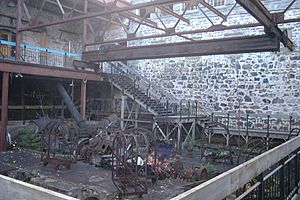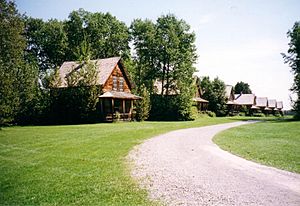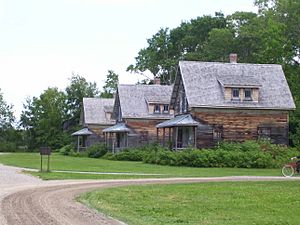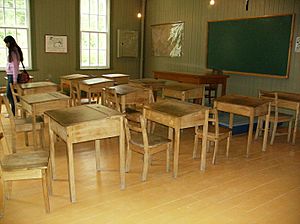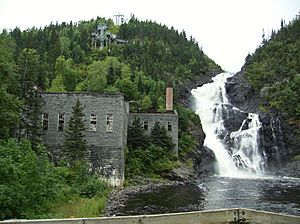Val-Jalbert facts for kids
Val-Jalbert is a fascinating ghost town in Quebec, Canada. It's about 8 kilometers (5 miles) northwest of a town called Chambord. A ghost town is a place where almost everyone has left, leaving behind empty buildings.
This village started in 1901. It became successful because of a pulp mill built by Damase Jalbert near the beautiful Ouiatchouan Falls. But this success didn't last long. The mill suddenly closed in 1927, and soon the whole village became empty.
In 1960, Val-Jalbert was turned into a park. Today, it has over 70 original buildings that are still standing. Many people say it's the best-preserved ghost town in all of Canada!
Contents
What's in a Name?
The village was named after its founder, Damase Jalbert, who lived from 1842 to 1904. He started the Ouiatchouan Pulp Company in 1901. At first, the village was called Saint-Georges-de-Ouiatchouan, named after the river that flows through it. Later, in 1913, the Chicoutimi Pulp Company renamed it Val-Jalbert to honor Mr. Jalbert.
A Look Back in Time
How Val-Jalbert Became a Company Town
Val-Jalbert was founded in 1901 by Damase Jalbert. He built a paper mill there because many people in Britain and the U.S. needed newsprint (paper for newspapers). The location was perfect because two large waterfalls on the Ouiatchouan River could provide all the power needed for the machines. One waterfall was 72 meters (236 feet) high, and the other was 35 meters (115 feet) high!
After Damase Jalbert passed away in 1904, American investors bought the company. They carefully planned the village. There were different types of houses for workers, and the homes were separated from the main business area. The company also built modern things for the time, like electricity, sewers, running water, and even telephone service!
In 1909, another company, the Chicoutimi Pulp Company, bought the mill and continued to develop the village. Sadly, about ten years later, a sickness called the Spanish flu affected many people in the small town.
Why Val-Jalbert Became a Ghost Town
In 1927, the company that owned the mill stopped all operations. This happened because people didn't need as much of the type of pulp the mill made. Many workers hoped the mill would reopen and stayed in town until 1929. But then, the company told everyone to leave and boarded up the houses. The local priest and the nuns who taught at the school also left in September 1929.
The company eventually went out of business in 1949. The Quebec government then took ownership of the land, buildings, and the power from the waterfalls.
Val-Jalbert as a Tourist Spot
In the 1960s, the site was opened to visitors. It became a popular place for tourists. In 1987, it was given to a parks agency called SEPAQ, which wanted to make the village even better for visitors.
In 1996, the Quebec government officially recognized Val-Jalbert as a special heritage site. This means it's an important historical place to protect. Today, the village is part of the Chambord municipality.
In the 2000s, the local government of the Domaine-du-Roy area took over managing the site. In 2009, they received $17 million from the Quebec and federal governments to improve the facilities. These improvements helped more people visit the village each year.
The Ouiatchouan River Dam Project
In 2009, a group announced plans to build a power plant near the old mill. This plant would use the river's water to make electricity. They also planned to build a dam above the Ouiatchouan Falls. Many people in the nearby towns were worried about this project. They thought it would change the beautiful waterfall.
Val-Jalbert is famous for its waterfall, and many tourists come just to see it. The company building the dam said they would make sure enough water flowed over the falls during the day for tourists to enjoy. But at night and during the winter, much less water would flow, making the falls look very different.
Many groups and people tried to stop the dam from being built to protect the river and its falls. They held protests and shared their concerns. Despite the opposition, the Quebec government approved the project in December 2012. Construction on the power plant and dam began in early 2013. Even after construction started, many people in the area still disagreed with the project.
See also
 In Spanish: Val-Jalbert para niños
In Spanish: Val-Jalbert para niños


